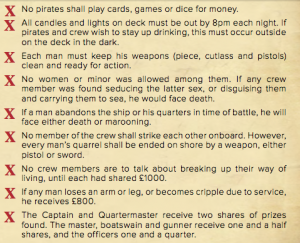Since man began setting sail to sea, members of the crew and the vessel officers drafted many different kinds of “handshake deals” – concerning pay, a share of wealth in any discoveries made, job outlines, and more. These “handshake deals” or “articles of agreement” became independent of any nation in authority, and in retrospect, were known as the Pirate Code. The Pirate Code emerged somewhere between 1620 and 1720, in a time known as the Golden Age of Piracy, and was written up by the captain of each vessel.
If one wanted to become an official member of a pirate ship, one would need to sign their name on a document which described the ship rules, the share in “treasure”, and forms of punishment for crew members who did not obey instructions. After signing the pirate code, the crew member would have to take an oath of honour and allegiance, with one hand placed on a ship weapon (sword, skull, axe) or a bible.
During the Golden Age of Piracy, countless pirate codes were used onboard ships. Unfortunately, due to pirates destroying these codes through burning or throwing overboard in attempts to hide them from authorities, there is not much known about the pirate codes. In fact, there are only nine complete or almost complete sets of articles which have survived and been preserved.
Captain Bartholomew Roberts was potentially one of the most well-known pirates, with rumours telling he plundered at least 400 ships. Often dubbed as “black bart”, his actions were often violent and non-hesitant to committing cruel deeds. Having a code of conduct put in place was of high importance on each pirate ship, as they were not governed by any rules, such as the naval regulations. Roberts’ pirate code articles were kept and preserved, with 11 articles (or codes) put into place.
Each pirate had a say and vote in the affairs of the moment. Each pirate has equal rights to liqueur or fresh provisions at any time when not in scarcity.
Each man was to be called in turn fairly by the list, because on top of their proper share, they are also entitled to a shift in clothes. If, however, a man defrauds the ship/company of even one dollar in money, jewels or plates, the man shall be marooned (abandoning someone on a deserted island or somewhere remote).

This set of codes was pretty standard among all pirates, though some were slightly modified versions. Other pirates codes included articles, such as: killing a surrendered enemy is not allowed; any pirate who falls behind is abandoned; and rules when the musicians must take a holiday. Eventually, most of the various codes merged into one, which looked most like Bartholomew Roberts’ code. If pirates broke any of the codes, they faced severe punishments – walking the plank, marooning (abandoning them on a deserted island), or death. When pirates survive and did finally reach port, they would spend their treasure on all things prohibited on the ship: women, gambling and the high life.
Despite the hook-armed, peg legged, parrot and Jolly Roger imagery that comes to mind when you think “pirate”, the real pirates were extremely organised and had a structured life onboard.
By Sophia Sorensen
/jul-sep2019



























